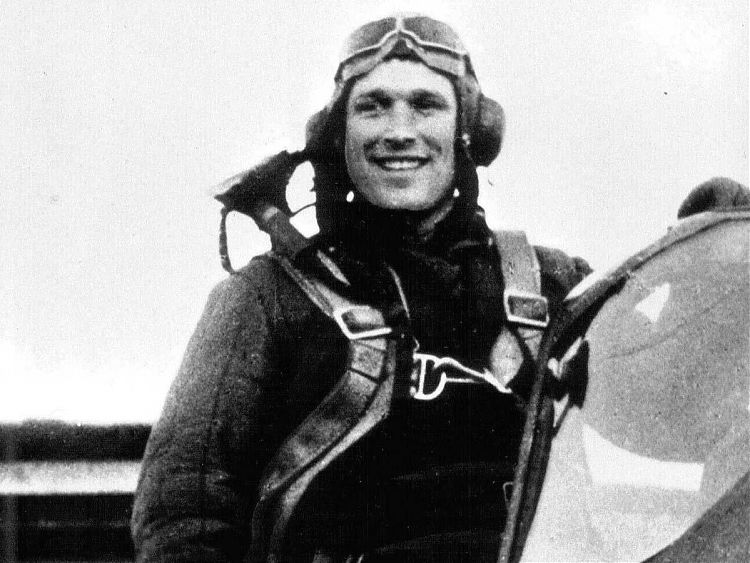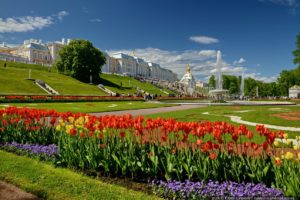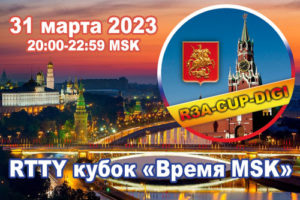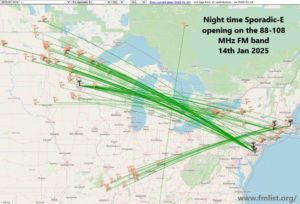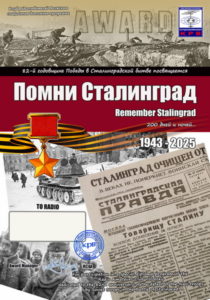Activity Days for the 105th anniversary of Boris Safonov 22-30 August 2020
From 22.08.2020 to 30.08.2020 the Club of radio amateur aviators “Fifth Ocean” holds days of activity dedicated to the 105th anniversary of the birth of Boris Safonov, a fighter pilot of the Navy of the Northern Fleet, the first two times Hero of the Soviet Union.
Boris Safonov (26.08.1915 – 30.05.1942) – fighter pilot of the Northern Fleet’s naval aviation. He was the first of those who was twice awarded the title of Hero of the Soviet Union for his exploits in the Great Patriotic War, the best Soviet pilot of 1941-1942.
Born in the village of Sinyavino, now Plavsky district of Tula region, on August 26, 1915, in a peasant family. Russian.
After graduating with honors seven years, he entered the Tula Railway School FZU, in 1930 joined the Komsomol, was engaged in the gliding school. Among the best cadets was enrolled in the school Osoaviachima, which was later renamed the Tula Airclub. It was there that the qualities necessary for the pilot were formed – independence, self-confidence, stamina, and discipline. Safonov fell into the group of instructor Valentina Grizodubova, who later became a Hero of the Soviet Union and entered many glorious pages in the history of Soviet aviation.
For the first time, Boris took the handle of the U-2 plane and was praised by the instructor: “Well done!” One of the first Boris Safonov took off on his own – there’s no need to be surprised: an outstanding pilot herself, Valentina Stepanovna, noticed in Boris what is called talent.
In August 1933, after the successful completion of the flying club, Safonov went to study at the 1st military school of pilots named after A. F. Myasnikov (Kacha).
After finishing school in November 1934, at the age of nineteen, Boris Safonov became a fighter pilot. He received the highest marks in the piloting technique, air shooting, and knowledge of the material part. In addition, it was noted in the characteristic that he has a fast reaction in the air, resourceful, intelligent, and sufficiently proactive. Perhaps a few words from this characteristic convey the essence of Safonov’s flying character: “Likes air combat. Safonov was enrolled as a pilot in the 7th Separate Aviation Squadron. Dzerzhinsky 2nd Air Brigade of the Belarusian Military District (later – the 106th Fighter Squadron named after A. S. Pavlov) was enrolled as a pilot in the 7th separate aviation squadron. Later – 106th Fighter Squadron of Dzerzhinsky and then 15th Fighter Regiment of the Belarusian Military District. F. E. Dzerzhinsky fighter squadron). When the question about the choice of the further place of service arose, Safonov immediately enrolled in the North, and at the end of December 1939 as part of the 2nd air squadron of the 15th IAA arrived in the Northern Fleet. The squadron became part of the newly formed 72nd Mixed Aviation Regiment of the NF Air Force, where young Lieutenant Safonov was appointed to the post of commander of the 1st Fighter Squadron, flying on I-15 bis aircraft.
The desire to improve the quality of aircraft piloting and accuracy of shooting, reflection on the tactics of the fighters allowed Safonov before the war to develop the basic rules of air combat. He, for example, already then considered the best fighter unit – a pair of planes, and the link should consist of four planes. Subsequent battles of the Great Patriotic War showed how right Safonov was.
BF Safonov met the Great Patriotic War squadron commander of the 72nd mixed aviation regiment of the Northern Fleet, in which no combat mission was performed without the direct participation of its commander. The pilots of the regiment started the war on outdated I-16 fighters (flying on these machines, Safonov made 109 combat flights, and shot down 17 enemy planes). On the left side of the fuselage of his I-16 (flight number 11), B.F. Safonov made large letters – “For Stalin!”, and on the right side – “Death to fascists!
Safonov won his first victory on the evening of June 24, 1941. After flying his I-16 to intercept the reconnaissance Ju-88 (identified as Ne-111), he attacked it after a long chase and shot it down. It was the first German aircraft shot down by North Sea pilots.
There were no trifles in the air for Safonov – everything was subject to achieving victory. To reduce the time of takeoff on the alarm, he even cut the buckles from his helmet, sewing the buttons from the parachute knapsacks in their place, and made the same thing to do his comrades. In the sky, he never flew in a straight line. His junior I-16 would go down and maneuver between the hills, and then soar up. The same pirouettes had to be written out by his wingmen as well. With each fight, he continued to improve his fighter tactics. His group, as a rule, was divided into two parts, one of which attacked the bombers, and the other tied up the enemy fighters.
July 14, 1941, Boris Safonov received the first award – the Order of the Red Banner. By August 28, the account of Captain Safonov was already 10 victories, and he was introduced to the title Hero of the Soviet Union. Among those he shot down were: He-111, 5 Ju-88, 2 Hs-126, Ju-87, and Bf-109.
On September 15, 1941, seven fighters under his command, enter into a battle with the enemy forces superior by almost 8 times, destroys 13 enemy planes without losing any of his. Safonov personally shoots down 3 planes (Bf-110, Ju-87, and Hs-126).
According to the Decree of the Presidium of the Supreme Soviet of the USSR of September 16, 1941, for heroism, courage, and bravery shown in the battles with the Nazi invaders, the squadron commander of the 72nd Saps of the Northern Fleet Air Force Captain BF Safonov was awarded the title Hero of the Soviet Union, with the Order of Lenin and the Gold Star Medal. (№ 533).
By the time of publication of this Decree, the pilots of the squadron had about 50 air victories, 16 of them – on the account of its commander.
In September 1941, when the airfield, where the “Safonov’s squadron” was based, British pilots of 151 air wings of the British Royal Air Force settled on Hurricane fighters. Excellent flight training allowed Safonov first in the Northern Fleet to master the new fighter just after a day of study, along with the British Komets Miller. And after only 10 days, the other pilots of the squadron mastered these machines. The Englishman Hubert Griffith remembered later:
“It was a more than the capable pilot, an outstanding shooter, as it later turned out in a pistol shooting competition. Safonov was a typical Russian, stocky, solid, methodical, and unhurried… When Safonov took off on Hurricane, having checked everything before, he showed a direct take-off, gained 1,500 feet, and started the first turn. His landing was appropriate – made two or three neat laps and landed demonstrably…”
The key style by that time had become quite clear: if possible, an unexpected and covert approach to the enemy, then an attack at maximum speed and opening of sighting fire on the cockpit or vital units of the aircraft from a distance of no more than 100 meters. “Observation, quick reaction, the ability to instantly make the right decision – the main qualities of a fighter pilot,” – said Safonov.
On October 24, 1941, Major B.F. Safonov was appointed commander of the new 78th IAE of the NF. The Commander of the Air Force gave Safonov the right to select pilots at his own discretion. Eight former instructors with good flight training were sent to the regiment. The regiment’s armament consisted of 27 Hurricanes.
He increases the account of shot down enemy aircraft, and for one month – from December 22, 1941, to January 22, 1942, is awarded the second and third Orders of the Red Banner.
The commander’s duties made significant adjustments in his frontline life. Flying on tasks was less, devoting time to planning air operations and careful management. He pays special attention to the education of young pilots; often flies with them on combat missions. Among those who owe they’re becoming Safonov, the famous Asses N. Bokiy, V. Pokrovsky, P. Klimov, P. Orlov, Z. Sorokin, P. Sgibnev, N. Didenko (13 of the – Heroes of the USSR).
In March 1942 Safonov, together with A. Kovalenko, A. Kukharenko, and T. Tumanov were awarded the British Order of “DAF-C” – “Cross for Flight Services.
March 20, 1942, Lieutenant Colonel BF Safonov was appointed commander of the regiment, which began to fight, the regiment at that time became the Guards – 2nd Guards mixed air regiment of the Air Force of the NF, and Safonov took his Guards banner. He flies less, giving a lot of time to the leadership of the combat activities of the unit and organizational and economic affairs. The regiment began arming itself with American Kittyhawk P-40 aircraft. The commander of the regiment was the first to master the new fighter.
Its last – 224th combat flight of the Guards Lieutenant Colonel BF Safonov made May 30, 1942, to cover the convoy of allies PQ-16, which was on its way to Murmansk. Forty-five “Junkers”, covered by “Messerschmitt”, took part in the raid on the caravan.
At ten o’clock, the four manned by brave North Sea pilots climbed into the frowning sky of May. The American-made Curtis P-40 “Kittyhawk” fighters were not adapted for operation in the harsh conditions of the Arctic – their engines often failed. The malfunctions happened in this flight as well. A. Kuharenko, Safonov’s leader, was forced to return soon after takeoff due to engine malfunctions…
On the way to the caravan, Safonov’s group met 6 German bombers Ju-88 and, chasing them, split up. Safonov was left alone. Shortly after the start of the battle, he broadcast: “One down”. A minute or two later a new message followed: “Two knocked down! I hit the third one… There’s a third one!” One minute later: “Cover your tail!… Action!” Those were the last words of Lieutenant Colonel Boris Safonov’s guard.
By order of the Fleet Commander, the flag is lowered on warships passing by the place of the death of the Guard Lieutenant Colonel Safonov, and the personnel, free from the watch, pays tribute to the memory of the famous North Sea pilot, twice Hero of the Soviet Union Boris Safonov.
By the Decree of the Presidium of the Supreme Soviet of the USSR on June 14, 1942, Safonov was awarded the second medal “Gold Star”. To this high rank he was represented by the People’s Commissar of the Navy N.G. Kuznetsov not posthumously, but during his lifetime, on May 27, 1942 – three days before his last combat flight.
Safonov did not live and 27 years, spent less than a year, half of this time as a regimental commander, while about a month ill and was in the hospital. He fought in cars, technically significantly inferior to the enemy aircraft, he did not have the opportunity to assess the combat strength of “Lavochkin”, “Jacob”, but he was the first of the Soviet pilots, who already in May 1942 had 20 enemy aircraft on the battle account of personally destroyed, and 5 more in group battles (there is evidence that Safonov had more personally destroyed aircraft, up to 30 pcs.).
B.F. Safonov’s combat merits were embodied not only in the enemy planes destroyed by him. Under his leadership, dozens of air fighters who later became Heroes of the Soviet Union have grown and gained considerable combat experience in the aviation of the Northern Fleet.
Twice Hero of the Soviet Union Boris Safonov was forever enrolled in the lists of the 2nd Guards Red Banner of the Air Force of the Northern Fleet. On June 15, 1942, the 2nd Guards SAP of the Air Force of the North Fleet was named twice Hero of the Soviet Union Boris Safonov.
In addition to two awards “Gold Star”, B.F. Safonov was awarded the Order of Lenin (16.09.1941), 3 Orders of the Red Banner (14.07.1941, 22.12.1941, 22.01.1942) and the highest aviation award of Great Britain – the Order of “DF-S” – “Big Silver Cross” (19.03.1942).
August 26, 2020, Boris Safonov’s birthday is celebrated for the 105th time.
Paying tribute to the memory and respect, courage and heroism of the famous fighter pilot of naval aviation of the Northern Fleet, the first twice Hero of the Soviet Union, the club of radio amateurs-aviators “Fifth Ocean” holds days of activity from 22.08.2020 to 30.08.2020, established a diploma “Fearless Falcon of the North” dedicated to this event.
Radio amateurs from all countries of the world are invited to conduct radio communications/observations with radio amateurs members of the club “Fifth Ocean” on bands 1.8 – 28 MHz and VHF.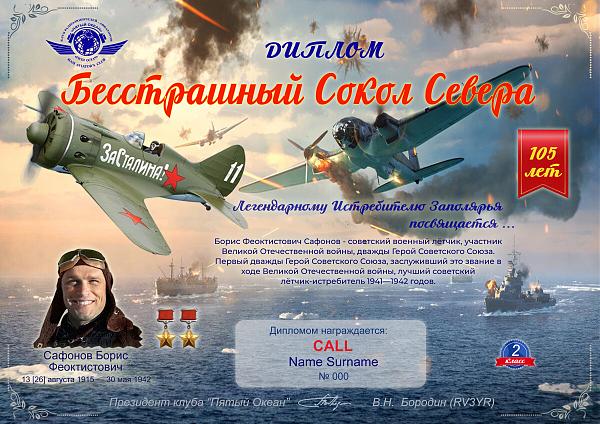
Terms of the diploma “Fearless Falcon of the North”.
Links to the diploma are counted from August 22, 2020, to December 31, 2020.
The necessary number of points to gain to fulfill the conditions of the diploma is 105.
The procedure for calculating points:
- For QSO/SWL with radio amateurs members of the club “Fifth Ocean”, working call sign …/AM – 7 points;
- For QSO/SWL with the collective radio station of the club “Fifth Ocean”, RY1Y – 7 points;
- For QSO/SWL with honorary members of Fifth Ocean Club: U4MIR, R2DAV, R5DU, RA3YV, RV3D, RV3YR, RA4AO, RA6F, UA1ZZ, UA3DJ, LZ1HM, LZ1ZF – 5 points;
- For QSO/SWL with radio amateurs members of the Fifth Ocean club – 3 points;
- For QSO/SWL with radio amateurs members of the club “Fifth Ocean” on VHF and 160 m band 1 point is added to the above points;
- For 1 QSO/SWL with amateur radio amateur members of the Fifth Ocean Club, a diploma is issued through the EIS or EME.
- Russia, Belarus, Ukraine, Moldova, Lithuania, Latvia, Estonia, Kazakhstan, Uzbekistan, Tajikistan, Kirgizstan, Georgia, Armenia, Azerbaijan – 1;
- Europe (except for the countries listed) – 2;
- Asia, including radio amateurs of Russia from 19 zones (except the listed countries) – 3;
- North and South America, Africa, Australia and Oceania, Antarctica – 5.
Repeated QSOs are allowed only on different bands and different types of radiation.
Repeated QSOs are only allowed on different bands and different types of radiation.
All types of digital links (RTTY, PSK, MFSK, SSTV, JT64, FT8, etc.) are counted as one type of DIGI.
On the days of activity of radio amateurs of the club “Fifth Ocean” from 22.08.2020 to 30.08.2020 points for conducted radio communications are doubled.
Activators, members of the club “Fifth Ocean”, a diploma with a number in sequence with the index “A”, is issued depending on the number of QSO:
- 3rd-grade diploma for 100 QSOs;
- 2nd-grade diploma for 250 QSOs;
- 1-grade diploma for 500 QSOs;
- the diploma “Master” for 1000 QSO.
A prerequisite is that you confirm the QSO on the HAMLOG resource.
The diploma is issued free of charge electronically through this resource.
Members of the Fifth Ocean Club during and after their activity days can receive the diploma as applicants in the general order.
If you have found a spelling error, please, notify us by selecting that text and pressing Ctrl+Enter.
